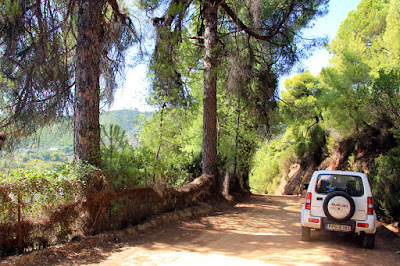There was no post-Ophelia rush of Redwings on Wednesday with just a single one caught out of the less than 40 birds on the move. Andy and I met up again on Thursday where we hoped to improve on our previous catch and also to witness something in the way of visible migration. October is generally one of the better months to do so, weather permitting.
Visible migration "vis-mig" is the observation of bird migration during daylight hours, a bird watching principle pioneered by Dutch ornithologists in the 1940's. At suitable locations and at the appropriate times of the year it is possible to detect bird migration as birds follow their favoured habitats and routes to reach their destinations.
Under certain conditions at Oakenclough, near Barnacre on the edge of the Pennines and looking north to distant Morecambe Bay about 12 miles away, we sometimes see migration in action. This is especially so in the autumn when birds on migration south pass to the west of us as they keep the coast in sight, and/or they fly to the east by following the Pennine escarpment. Many times they simply pass directly overhead and, if we are lucky, a number of birds decide to rest up and feed in the woodland plantation that is our ringing site.
Location of Oakenclough ringing site
Thursday proved to be one such occasion, a morning to witness visible migration on a large scale. The highlight of our five plus hours, and taking opportunities between spells of ringing birds, we counted a prolonged passage of some 2,350+ Redwings and hundreds of finches - 250+ Chaffinches, 40+ Goldfinches, 40+ Lesser Redpolls and 2+ Bramblings.
The first Redwings arrived from all directions north soon after dawn with a continuous arrival until we left soon after midday. Parties and flocks numbered anywhere between 5 and 130 birds, some of which fed on site for a while before they carried on south and out of sight. Our count of 2,350 Redwings can be considered a minimum within our narrow corridor of observation and when birds flew north to south on a broad east to west front
Mixed in with the large number of Redwings were a handful of larger thrushes and which from a distance in the grey, cloudy morning we assumed were Fieldfares. Further into the morning and when we actually caught two Mistle Thrush, most unusual in itself and in the absence of any definite Fieldfares, we decided that our earlier sightings were Mistle Thrushes migrating with the Redwing flocks. So now well into October I have yet to see a definite Fieldfare, and they too are a little late to appear in numbers.
Finch arrivals started later in the morning with groups and small flocks of between 4 and 40 birds. A single Chaffinch proved to be the only one caught out of the several hundred on the move as none of the flocks stopped off to feed. We had better luck with Lesser Redpolls and added another eight to our recent catches of the species.
In all we caught 50 of the birds that stopped off in the plantation - 23 Redwing, 8 Lesser Redpoll, 6 Goldfinch, 5 Goldcrest, 2 Mistle Thrush, 2 Blue Tit and singles of Long-tailed Tit, Blackbird, Chaffinch and Great Tit.
Redwing
Lesser Redpoll
Redwing
Mistle Thrush
Mistle Thrush
Chaffinch
Other birds seen – 4 Pied Wagtail, 1 Sparrowhawk, 2 Buzzard.
Hurricane Brian
Seems there’s another hurricane on the way - a Storm Bomb named Brian. Don’t you just love the British weather?
Linking today to viewingnaturewitheileen.blogspot.co.uk/.
Linking today to viewingnaturewitheileen.blogspot.co.uk/.



































































































